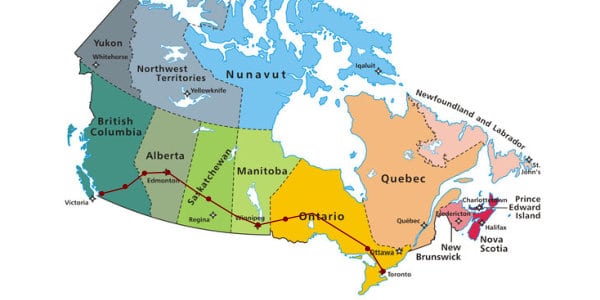A very red sunrise awakens us at five in the morning, revealing that we are on the outskirts of Edmonton, having crossed into Alberta overnight. Delays to permit two long, lumbering freight trains to pass result in our late arrival at the one stopover permitted us on this trip, at Jasper, only hours before the car-rental office closes for the day. As we have to drive to Lake Louise, three hours and 230 kilometres away, we know time is of the essence. The scenery is spectacular: forbidding grim mountain peaks, like impregnable fortress fastnesses from Tolkien’s Mordor either
frown disapprovingly down on us, or feign sublime indifference to our passage. It is May 29, but some lakes still have ice and snow on their surface, despite the 15 degree Centigrade air temperature. It is cooler in the forest, where dirty snow lurks undiscovered by the sun. We make Lake Louise in time for me to surprise Louise with dinner in the splendid Fairmont Lake Louise hotel on her birthday.
On the way back to Jasper the next day, we visit the aptly-named Emerald Lake, and see from a distance the ‘spiral tunnels’ near the Kicking Horse Pass designed in the 1880s to slow runaway trains—mercifully, such tunnels are no longer needed—and then climb a steep trail still covered in snow to eat a picnic lunch at the overlook high above Peyto Lake, its stunning turquoise colour the product of fine silt brought down by the Peyto Glacier and suspended in the lake water. We arrive in Jasper only to discover that the VIA train that is to take us on to Vancouver has been delayed, and we must spend the night in town. Fortunately, this is not a major setback, as we have time to make use of a laundromat, take a swim in Jasper’s magnificent indoor aquatic centre, explore the town, talk to some friendly locals, and mingle with other tourists. VIA even pays for our supper, apologizing profusely for the delay.
We finally board the train for Vancouver in the small hours of the night of the following day, the arriving train having been delayed even longer by a stalled freight train heading east. We awake at 7:15 a.m. to find it is really an hour earlier, as ‘Mountain Time’ has yielded to ‘Pacific Time’ during the night. We spend most of the day under the dome watching majestic scenery pass by. This includes the constantly-changing view of the Fraser River valley and its canyons, which passengers on the regular schedule would have slept through, glimpses of the North Thompson River with forested slopes on both riverbanks, and the astonishing length of Kamloops Lake. We then follow the Thompson River. This is dry ‘high country,’ with bald eagles’ nests in dead trees and on top of telegraph poles. The plateau is the source of the Fraser, Skeena, Columbia, Peace, Yukon, and Liard rivers, but the landscape is reminiscent of Arizona, the predominant vegetation, oddly, being sagebrush. We see no cowboys or cactus, however. We pass Black Canyon, named for its coal, and White Canyon, named for its chalk deposits, and then the confluence of the Thompson’s green waters with the brown waters of the mighty Fraser, both colours combining in a fearsome whirlpool. As the river valley widens, the shores on either side appear to rise to impressive heights made possible by the ever-deepening burrowing of the force of river water. We are at one point more than a hundred feet above the rushing flow. In the distance, we catch brief glimpses of snowy mountain peaks. We pass “Hell’s Gate,” the narrowest point on the Fraser River, where an enterprising tour operator has installed both a cable car and a pedestrian bridge across the canyon above the angry, turbulent waters. We pass through numerous tunnels, watch the rival but considerably more expensive Rocky Mountaineer train taking its well-heeled passengers in the opposite direction on a railway line on the other side.
Eventually, in the early evening, we trundle slowly and anti-climactically into Pacific Central Station, the Vancouver terminus for VIA’s The Canadian passenger service. We enter by way of the eyesore of Burnaby’s grubby breakers’ yards and container depot. We have crossed a continent, from Lake Ontario to the Pacific Ocean, and met interesting fellow-travellers from across the nation and abroad, chiefly Americans, Britons, and Australians, mostly of retirement age. We have been treated to excellent cuisine and cheerful service. We have been accorded the privilege of armchair viewing of the great unspoiled wilderness at the heart of the True North. Waiting for freight trains is undeniably frustrating, but this is outweighed by the thoughtful traveller’s realization that his trip — and everyone else’s — is heavily subsidized by the Canadian taxpayer. We went on from Vancouver to Victoria, and then flew home, but that is another story….





